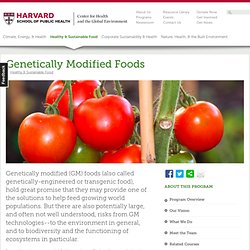

'Hunger Games' Science: Investigating Genetically Engineered Organisms. Overview | What lessons can we learn about genetically engineered organisms from the example of the jabberjay, a fictional bird in the movie “The Hunger Games”?

In this lesson, students discuss the definition of genetically modified organisms, learn about the risks and benefits of research on G.M.O.’s, explore the growing do-it-yourself biology movement, and develop proposals seeking to either restrict or permit research into genetically modifying the avian flu virus. Materials | Computers with Internet access Warm-up | Before students arrive, write the following prompt on the board: In the movie “The Hunger Games,” the Capitol (a term used to refer to what we would call the government) produced genetically enhanced birds called jabberjays to spy on rebels. Unexpectedly, these birds bred with mockingbirds, creating a new hybrid bird called the mockingjay. When students arrive, allow several minutes for them to reply individually to this prompt in their journals. 1. 2. 3. 4. Science 8.
Lesson Plan: The Impact of Genetically Modified Seeds. Jump to: INTRODUCTION: This lesson plan utilizes the film and POV’s website resources for Food, Inc., a documentary that examines food in the United States and the industry that produces it.

Classrooms can use these materials to explore the benefits and controversies of using genetically modified seeds. POV documentaries can be recorded off-the-air and used for educational purposes for up to one year from their initial broadcast. In addition, POV offers a lending library of DVDs and VHS tapes that you can borrow any time during the school year — FOR FREE! Get started by joining our Community Network. Please visit our Film Library to find other films suitable for classroom use. By the end of this lesson, students will: SUBJECT AREAS: Economics, Civics, U.S.
Method of showing the entire class online video and Web pages ESTIMATED TIME NEEDED: One 50-minute class period Top of Page. Food, Genetically modified. Genetically engineered foods: MedlinePlus Medical Encyclopedia. Genetically engineered foods have had foreign genes (genes from other plants or animals) inserted into their genetic codes.

Genetic engineering can be done with plants, animals, or microorganisms. Historically, farmers bred plants and animals for thousands of years to produce the desired traits. For example, they produced dogs ranging from poodles to Great Danes, and roses from sweet-smelling miniatures to today's long-lasting, but scent-free reds. Selective breeding over time created these wide variations, but the process depended on nature to produce the desired gene.
Humans then chose to mate individual animals or plants that carried the particular gene in order to make the desired characteristics more common or more pronounced. Genetic engineering allows scientists to speed this process up by moving desired genes from one plant into another -- or even from an animal to a plant or vice versa. Function Potential benefits of genetically engineered food include: Potential risks include: Genetically Modified Foods. Can you think of some possible risks of growing plants that contain genes from other organisms?

Let's examine our earlier examples: the beetle-resistant tomato, the vaccination banana, and the saltwater rice plant. We've already covered the potential advantages of these plants, but what are the concerns? Cross-breeding with wild populations. For all of these examples, a primary concern is preventing genetically modified versions from mixing with the naturally existing populations of plants from which they're derived. Plants rely on the transfer of pollen, via insects or the air, to breed and produce offspring, and it's difficult to control how they cross-breed in the wild. In most cases, it's not yet clear how introduction of the non-native gene would affect wild populations.
Toxicity or allergic reactions. Biotechnology > Questions & Answers on Food from Genetically Engineered Plants. For additional information, see Foods Derived from Genetically Engineered Plants en Espanol 1.

What is genetic engineering? Genetic engineering is the name for certain methods that scientists use to introduce new traits or characteristics to an organism. For example, plants may be genetically engineered to produce characteristics to enhance the growth or nutritional profile of food crops. 2. FDA regulates genetically engineered animals in a different way. 3. 4. FDA teams of scientists knowledgeable in genetic engineering, toxicology, chemistry, nutrition, and other scientific areas as needed carefully evaluate the safety assessments taking into account relevant data and information. FDA considers a consultation to be complete only when its team of scientists are satisfied with the developer’s safety assessment and have no further questions regarding safety or regulatory issues.
The Center for Health and the Global Environment. Genetically modified (GM) foods (also called genetically-engineered or transgenic food), hold great promise that they may provide one of the solutions to help feed growing world populations.

But there are also potentially large, and often not well understood, risks from GM technologies--to the environment in general, and to biodiversity and the functioning of ecosystems in particular. Among the major successes cited for the genetic modification of crops are the insertion of Bt genes (that produce insect pathogens, derived from strains of the bacteriumBacillus thuringiensis) into maize, potatoes, and cotton to make these crops resistant to certain insect pests, and of herbicide-tolerance genes that allow GM crops to thrive despite being exposed to certain herbicides. However, behind these and other successes of genetic modification, lurk unexpected effects and potential pitfalls.